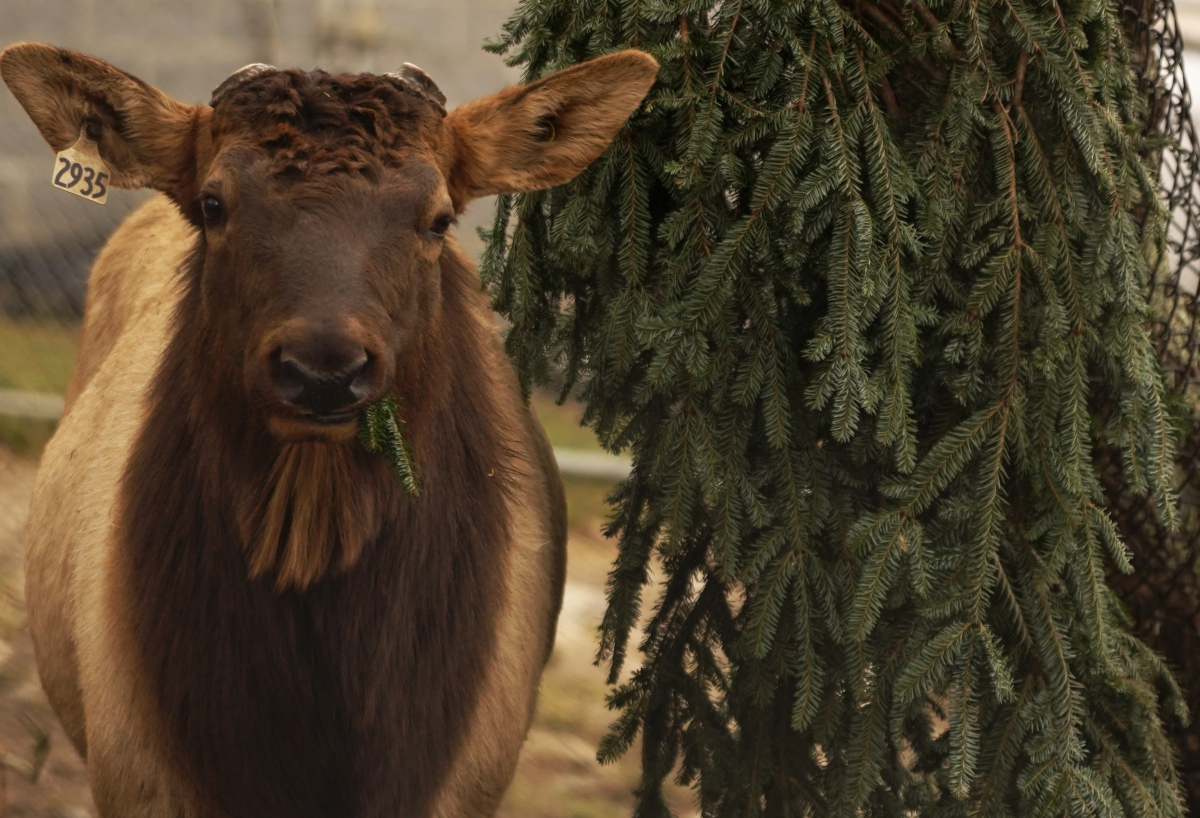Grandfather Mountain animal habitats prepare for winter
 Merle, one of Grandfather Mountain’s resident elk, munches on a donated Fraser fir — a special holiday enrichment provided to the park’s habitat animals. Photo by Luke Barber | Grandfather Mountain Stewardship Foundation
Merle, one of Grandfather Mountain’s resident elk, munches on a donated Fraser fir — a special holiday enrichment provided to the park’s habitat animals. Photo by Luke Barber | Grandfather Mountain Stewardship Foundation
Trimming a tree for the holidays? So are Grandfather Mountain’s resident elk. Each year, the resident animals at Grandfather Mountain receive a special holiday enrichment, courtesy of the area’s local Christmas tree farms.
Each year, farmers donate leftover Fraser fir Christmas trees, which are given to Grandfather’s habitat animals as enrichments — special treats that help keep them active and intellectually stimulated.
According to Christie Tipton, chief habitats curator for the Grandfather Mountain Stewardship Foundation, the nonprofit organization that owns and operates the Linville, N.C., nature park, each animal reacts differently to receiving the Christmas trees.
The black bears enjoy the fragrance and unique aroma of the trees, she said, while the river otters will crawl inside of them and even make beds with the branches. Meanwhile, the elk tend to treat the trees like a holiday meal.
“The elk love to eat them, believe it or not,” Tipton said. “For them, the trees are a very tasty treat. They will even nibble on them when out in the wild. In the wintertime for wild elk, there’s not fresh grass to eat, and vegetation has died off. So, the elk will go around and eat what’s available to them, and evergreen trees are one of those staples.”
The arrival of these festive firs often coincides with the beginning of winter. For the parks’ black bears, it marks the time when they enter into a quasi-hibernation.
Black bears, like most other bears, are not true hibernators. They consume significantly more calories with the approach of cold weather, slowly stop eating and then go into a den in a protected location to sleep for the winter.
Since those who reside at Grandfather Mountain are fed by their keepers, habitat staff simulates winter feeding patterns to enable the bears’ innate instinct to hibernate.
Tipton explained that the process begins all the way back in late summer and early fall, when the bears’ diet is increased in order for them to accumulate fat supply in preparation for the months ahead.
“At the end of summer and beginning of fall, we start increasing their fat supply for the winter,” she said. “We watch their weight very carefully. Then as we get closer to winter, we begin to decrease their food in order to mimic what happens in the wild. For example, they’ll get a massive amount of acorns and all this stuff for them to eat, and they gorge on it. Then as winter comes, the food supply dwindles away.”
They’ll then enter their dens to sleep the winter days away. However, during bouts of warmer weather, like this December, it’s not unusual to see them sleepily wandering around their habitat, searching for morsels of food.
“With all the other animals, we take care of them just like we do during spring, summer and fall,” Tipton said. “The otters are actually a little more active during the wintertime, because they like colder temperatures.”
The river otters are especially fond of snow. When there’s enough accumulation, they’re known to frolic, slide around on their bellies, burrow and even make tunnels, which guests can watch develop from behind a glass enclosure.
“Each species we have up here is native to Grandfather Mountain,” Tipton said, including the resident bald eagles and elk. “They all have physical characteristics and traits that allow them to thrive in environments like this.”
Throughout the winter, the staff also has to make sure ice doesn’t form over top of the ponds inside the animal habitats and that the lines which supply heat to the ponds remain functional. Even in the harshest of conditions, Tipton said the animals are always cared for. In the event of possible travel delays, they’ll also receive additional food and water.
“When we have a lot of snow, it can be difficult for us to get up here, and there have been times when we’ve had to hike up the mountain to the habitats,” she said.
In other words, sometimes, you just have to grin and bear it.





